
List of rulers of Brandenburg
Encyclopedia

This article lists the Margraves and Electors of Brandenburg
Brandenburg
Brandenburg is one of the sixteen federal-states of Germany. It lies in the east of the country and is one of the new federal states that were re-created in 1990 upon the reunification of the former West Germany and East Germany. The capital is Potsdam...
during the period of time that Brandenburg was a constituent state of the Holy Roman Empire
Holy Roman Empire
The Holy Roman Empire was a realm that existed from 962 to 1806 in Central Europe.It was ruled by the Holy Roman Emperor. Its character changed during the Middle Ages and the Early Modern period, when the power of the emperor gradually weakened in favour of the princes...
.
The Mark, or March, of Brandenburg was one of the primary constituent states of the Holy Roman Empire
Holy Roman Empire
The Holy Roman Empire was a realm that existed from 962 to 1806 in Central Europe.It was ruled by the Holy Roman Emperor. Its character changed during the Middle Ages and the Early Modern period, when the power of the emperor gradually weakened in favour of the princes...
. It was created in 1157 as the Margraviate of Brandenburg
Margraviate of Brandenburg
The Margraviate of Brandenburg was a major principality of the Holy Roman Empire from 1157 to 1806. Also known as the March of Brandenburg , it played a pivotal role in the history of Germany and Central Europe....
by Albert the Bear, Margrave of the Northern March
Northern March
The Northern March or North March was created out of the division of the vast Marca Geronis in 965. It initially comprised the northern third of the Marca and was part of the territorial organisation of areas conquered from the Wends...
. In 1356, by the terms of the Golden Bull
Golden Bull of 1356
The Golden Bull of 1356 was a decree issued by the Reichstag assembly in Nuremberg headed by the Luxembourg Emperor Charles IV that fixed, for a period of more than four hundred years, important aspects of the constitutional structure of the Holy Roman Empire...
of Charles IV
Charles IV, Holy Roman Emperor
Charles IV , born Wenceslaus , was the second king of Bohemia from the House of Luxembourg, and the first king of Bohemia to also become Holy Roman Emperor....
, the Margrave of Brandenburg was given the permanent right to participate in the election
Imperial election
The election of a Holy Roman Emperor or King of Germany was, from at least the 13th century, accomplished by a small body of the greatest princes of the Empire, the Prince-electors. Appointment as Emperor was normally for life...
of the Holy Roman Emperor
Holy Roman Emperor
The Holy Roman Emperor is a term used by historians to denote a medieval ruler who, as German King, had also received the title of "Emperor of the Romans" from the Pope...
with the title of Elector
Prince-elector
The Prince-electors of the Holy Roman Empire were the members of the electoral college of the Holy Roman Empire, having the function of electing the Roman king or, from the middle of the 16th century onwards, directly the Holy Roman Emperor.The heir-apparent to a prince-elector was known as an...
.
The early rulers came from several different dynasties, but from 1415 Brandenburg and its successor states were ruled by the House of Hohenzollern
House of Hohenzollern
The House of Hohenzollern is a noble family and royal dynasty of electors, kings and emperors of Prussia, Germany and Romania. It originated in the area around the town of Hechingen in Swabia during the 11th century. They took their name from their ancestral home, the Burg Hohenzollern castle near...
for over 500 years. The titles of Margrave of Brandenburg and Elector of Brandenburg were abolished along with the Holy Roman Empire in 1806. However the Hohenzollern-ruled state based in Berlin continued under the name of the Kingdom of Prussia
Kingdom of Prussia
The Kingdom of Prussia was a German kingdom from 1701 to 1918. Until the defeat of Germany in World War I, it comprised almost two-thirds of the area of the German Empire...
(the Hohenzollerns had been kings in Prussia since 1701 and Kings of Prussia since 1772.) From 1871 to 1918 the Hohenzollerns were also the German Emperor
German Emperor
This article is about the emperors of the German Empire. For full list of German monarchs before 1871, see List of German monarchs.The German Emperor was the official title of the Head of State and ruler of the German Empire, beginning with the proclamation of Wilhelm I as emperor during the...
s.
Margraves of Brandenburg
| Ascanian Dynasty | |||||
| Name | Reign | Comments | |||
| Albert I | 1157–1170 | Ruler of the Nordmark Northern March The Northern March or North March was created out of the division of the vast Marca Geronis in 965. It initially comprised the northern third of the Marca and was part of the territorial organisation of areas conquered from the Wends... from 1134. Called "Albert the Bear". | |||
| Otto I Otto I, Margrave of Brandenburg Otto I was the second Margrave of Brandenburg, from 1170 until his death.-Life:Otto I was born into the House of Ascania as the eldest son of Albert I , who founded the Margraviate of Brandenburg in 1157, and his wife Sophie von Winzenburg... | 1170–1184 | Son of Albert I. Ruled together with his father from 1144. | |||
| Otto II Otto II, Margrave of Brandenburg Otto II , called The Generous , was the third Margrave of Brandenburg from 1184 until his death.-Life:Otto II was born into the House of Ascania as the eldest son of Otto I and Judith, a daughter of the Piast Duke of Poland Bolesław III Wrymouth.After succeeding his father, he improved the defense... | 1184–1205 | Son of preceding. | |||
| Albert II Albert II, Margrave of Brandenburg Albert II, Margrave of Brandenburg was a member of the House of Ascania. He was Margrave of Brandenburg from 1205 until his death in 1220.- Life :... | 1205–1220 | Brother. | |||
|
| Co-rulers, sons of Albert II. | |||
| From 1266 to 1319, Brandenburg was held by the two lines of Brandenburg-Stendal and Brandenburg-Salzwedel, all of whom jointly shared the title of Margrave. | |||||
| Brandenburg-Stendal | Brandenburg-Salzwedel | ||||
Co-rulers, sons of John I:
| Co-rulers, sons of Otto III:
| ||||
Co-rulers:
| Co-rulers:
| ||||
| After the extinction of the Ascanian dynasty in 1320, Brandenburg came under the control of the Emperor Louis IV Louis IV, Holy Roman Emperor Louis IV , called the Bavarian, of the house of Wittelsbach, was the King of Germany from 1314, the King of Italy from 1327 and the Holy Roman Emperor from 1328.... of the House of Wittelsbach, who granted Brandenburg to his eldest son, Louis V of Bavaria. | |||||
| Wittelsbach Dynasty | |||||
| Name | Reign | Comments | |||
| Louis I Louis V, Duke of Bavaria Louis V, Duke of Bavaria, called the Brandenburger was Duke of Bavaria and as Louis I also Margrave of Brandenburg and Count of Tyrol. Louis V was the eldest son of Emperor Louis IV and his first wife Beatrix of Świdnica... "the Brandenburger" | 1323–51 | Cousin of Henry II, Son of Emperor Louis IV Louis IV, Holy Roman Emperor Louis IV , called the Bavarian, of the house of Wittelsbach, was the King of Germany from 1314, the King of Italy from 1327 and the Holy Roman Emperor from 1328.... . | |||
| Louis II Louis VI the Roman Louis the Roman was the eldest son of Emperor Louis IV the Bavarian by his second wife, Margaret II, Countess of Hainault, and a member of the House of Wittelsbach. Louis was Duke of Bavaria as Louis VI and Margrave of Brandenburg as Louis II... "the Roman". | 1351–56 | Half-brother of preceding; named Elector in 1356. | |||
Electors of Brandenburg
| Wittelsbach Dynasty | ||||
| Image | Name | Began | Ended | Comments |
| Louis II Louis VI the Roman Louis the Roman was the eldest son of Emperor Louis IV the Bavarian by his second wife, Margaret II, Countess of Hainault, and a member of the House of Wittelsbach. Louis was Duke of Bavaria as Louis VI and Margrave of Brandenburg as Louis II... Ludwig II | 10 January 1356 | 17 May 1365 | First Elector of Brandenburg. Called "the Roman" | |
| Otto VII Otto V, Duke of Bavaria Otto V, Duke of Bavaria , was a duke of Bavaria and Elector of Brandenburg as Otto VII. Otto was the fourth son of Holy Roman Emperor Louis IV by his second wife Margaret II of Avesnes, countess of Hainaut and Holland.-Biography:... | 17 May 1365 | 18 August 1373 | Brother of preceding. Co-ruler of Brandenburg with his brother from 1351, but as a minor (b. 1346) took no part in administration until his brother's death. Abdicated 1373 but retained Electoral title. Died 1379. | |
| Luxemburg Dynasty House of Luxembourg The House of Luxembourg was a late medieval German dynasty, which between 1308 and 1437 ruled the Holy Roman Empire, twice interrupted by the rivaling House of Wittelsbach.-History:... | ||||
| Image | Name | Began | Ended | Comments |
 | Wenceslaus Wenceslaus, King of the Romans Wenceslaus ) was, by election, German King from 1376 and, by inheritance, King of Bohemia from 1378. He was the third Bohemian and second German monarch of the Luxembourg dynasty... Wenzel | 2 October 1373 | 29 November 1378 | Emperor Charles IV Charles IV, Holy Roman Emperor Charles IV , born Wenceslaus , was the second king of Bohemia from the House of Luxembourg, and the first king of Bohemia to also become Holy Roman Emperor.... forced the last Wittelsbach Elector to abdicate, and then installed his own son, Wenceslaus. As Wenceslaus was still a minor (b. 1361), the Emperor administered the margraviate for him. |
 | Sigismund Sigismund, Holy Roman Emperor Sigismund of Luxemburg KG was King of Hungary, of Croatia from 1387 to 1437, of Bohemia from 1419, and Holy Roman Emperor for four years from 1433 until 1437, the last Emperor of the House of Luxemburg. He was also King of Italy from 1431, and of Germany from 1411... | 29 November 1378 | 1388 | Younger brother of Wenceslaus; took control of Brandenburg on his brother's ascension as King of Germany and Bohemia. Gave up Brandenburg to his cousin Jobst as security for a substantial loan. |
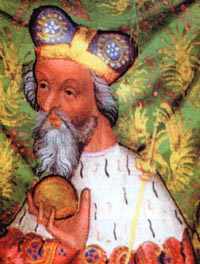 | Jobst Jobst of Moravia Jobst of Moravia, Jobst von Mähren from the House of Luxembourg was the eldest son of Margrave John Henry of Moravia, the younger brother of Emperor Charles IV.... | 1388 | 16 January 1411 | Sigismund's first cousin, nephew of Charles IV. Elected as German King in 1410 in opposition to Sigismund, but died very shortly afterwards. |
 | Sigismund | 16 January 1411 | 30 April 1415 | Following Jobst's death, Sigismund regained control of Brandenburg and was elected undisputed King of Germany. |
| Hohenzollern Dynasty House of Hohenzollern The House of Hohenzollern is a noble family and royal dynasty of electors, kings and emperors of Prussia, Germany and Romania. It originated in the area around the town of Hechingen in Swabia during the 11th century. They took their name from their ancestral home, the Burg Hohenzollern castle near... | ||||
| Image | Name | Began | Ended | Comments |
| Frederick I Frederick I, Elector of Brandenburg Frederick was Burgrave of Nuremberg as Frederick VI and Elector of Brandenburg as Frederick I. He was a son of Burgrave Frederick V of Nuremberg and Elisabeth of Meissen, and was the first member of the House of Hohenzollern to rule the Margraviate of Brandenburg.- Biography :Frederick entered... Friedrich I | 30 April 1415 | 20 September 1440 | Originally Burgrave of Nuremberg. Appointed by King Sigismund Sigismund, Holy Roman Emperor Sigismund of Luxemburg KG was King of Hungary, of Croatia from 1387 to 1437, of Bohemia from 1419, and Holy Roman Emperor for four years from 1433 until 1437, the last Emperor of the House of Luxemburg. He was also King of Italy from 1431, and of Germany from 1411... in 1415 and enfeoffed in 1417. His eldest son John the Alchemist John, Margrave of Brandenburg-Kulmbach John, nicknamed the Alchemist was a Margrave of Brandenburg-Kulmbach and served as the peace-loving Margrave of Brandenburg after the abdication of his father, Frederick I, the first member of the House of Hohenzollern to rule Brandenburg.-Biography:John was the eldest son of Frederick I,... administered Brandenburg as Margrave from 1425 to 1437, but Frederick retained the Electorship. | |
| Frederick II Frederick II, Elector of Brandenburg Frederick II of Brandenburg , nicknamed "the Iron" and sometimes "Irontooth" , was a Prince-elector of the Margraviate of Brandenburg from 1440 until his abdication in 1470, and was a member of the House of Hohenzollern.-Biography:Frederick II was born in Tangermünde to Frederick I, Brandenburg's... Friedrich II | 20 September 1440 | 10 February 1471 | Son of Frederick I. Called "Irontooth" . Administered Brandenburg from 1437 and became Elector on his father's death in 1440. | |
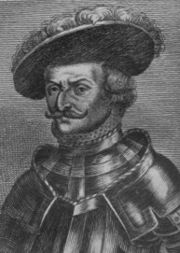 | Albert III Achilles Albrecht III Achilles | 10 February 1471 | 11 March 1486 | Brother. |
| John Cicero Johann Cicero | 11 March 1486 | 9 January 1499 | Son. | |
| Joachim I Nestor | 9 January 1499 | 11 July 1535 | Son. His younger brother, Albert Albert of Mainz Cardinal Albert of Hohenzollern was Elector and Archbishop of Mainz from 1514 to 1545, and Archbishop of Magdeburg from 1513 to 1545.-Biography:... was co-Margrave 1499-1513, but only Joachim was Elector. | |
| Joachim II Hector Joachim II Hector, Elector of Brandenburg Joachim II Hector was a Prince-elector of the Margraviate of Brandenburg . A member of the House of Hohenzollern, Joachim II was the son of Joachim I Nestor, Elector of Brandenburg, and his wife Elizabeth of Denmark, Norway, and Sweden... | 11 July 1535 | 3 January 1571 | Son. First Protestant Elector of Brandenburg. | |
| John George John George, Elector of Brandenburg John George of Brandenburg was a Prince-elector of the Margraviate of Brandenburg and a Duke of Prussia... Johann Georg | 3 January 1571 | 8 January 1598 | Son. | |
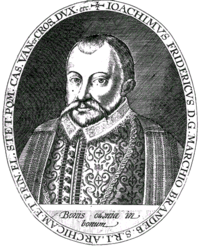 | Joachim Frederick Joachim Frederick, Elector of Brandenburg Joachim III Frederick , of the House of Hohenzollern, was Prince-elector of the Margraviate of Brandenburg from 1598 until his death.-Biography:... Joachim Friedrich | 8 January 1598 | 28 July 1608 | Son. |
 | John Sigismund John Sigismund, Elector of Brandenburg John Sigismund was a Prince-elector of the Margraviate of Brandenburg from the House of Hohenzollern. He also served as a Duke of Prussia.-Elector of Brandenburg and Duke of Prussia:... Johann Sigismund | 28 July 1608 | 3 November 1619 | Son. Duke of Prussia from 1618. |
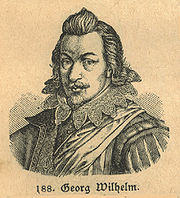 | George William George William, Elector of Brandenburg George William of Brandenburg , of the Hohenzollern dynasty, was margrave and elector of Brandenburg and duke of Prussia from 1619 until his death. His reign was marked by ineffective governance during the Thirty Years' War... Georg Wilhelm | 3 November 1619 | 1 December 1640 | Son. Ruled during the Thirty Years' War Thirty Years' War The Thirty Years' War was fought primarily in what is now Germany, and at various points involved most countries in Europe. It was one of the most destructive conflicts in European history.... . Also Duke of Prussia. |
| Frederick William Frederick William, Elector of Brandenburg |align=right|Frederick William was Elector of Brandenburg and Duke of Prussia – and thus ruler of Brandenburg-Prussia – from 1640 until his death. A member of the House of Hohenzollern, he is popularly known as the "Great Elector" because of his military and political prowess... Friedrich Wilhelm | 1 December 1640 | 9 May 1688 | Son. Called "the Great Elector". Also Duke of Prussia. | |
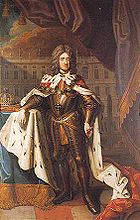 | Frederick III Friedrich III | 9 May 1688 | 25 February 1713 | Son. "King in Prussia King in Prussia King in Prussia was a title used by the Electors of Brandenburg from 1701 to 1772. Subsequently they used the title King of Prussia.... " as Frederick I from 1701; from here the ordinals reset |
| Frederick William I Frederick William I of Prussia Frederick William I of the House of Hohenzollern, was the King in Prussia and Elector of Brandenburg from 1713 until his death... Friedrich Wilhelm I | 25 February 1713 | 31 May 1740 | Son. King in Prussia. Called "the Soldier-King". | |
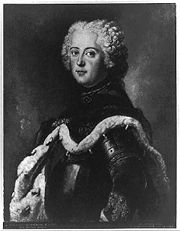 | Frederick II Frederick II of Prussia Frederick II was a King in Prussia and a King of Prussia from the Hohenzollern dynasty. In his role as a prince-elector of the Holy Roman Empire, he was also Elector of Brandenburg. He was in personal union the sovereign prince of the Principality of Neuchâtel... Friedrich II | 31 May 1740 | 17 August 1786 | Son. King in Prussia to 1772; after annexations of Polish Prussian territory, "King of Prussia". Called "Frederick the Great". |
| Frederick William II Frederick William II of Prussia Frederick William II was the King of Prussia, reigning from 1786 until his death. He was in personal union the Prince-Elector of Brandenburg and the sovereign prince of the Principality of Neuchâtel.-Early life:... Friedrich Wilhelm II | 17 August 1786 | 16 November 1797 | Nephew. King of Prussia. | |
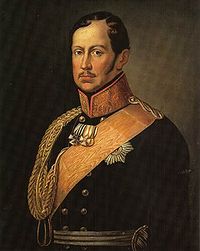 | Frederick William III Frederick William III of Prussia Frederick William III was king of Prussia from 1797 to 1840. He was in personal union the sovereign prince of the Principality of Neuchâtel .-Early life:... Friedrich Wilhelm III | 16 November 1797 | 6 August 1806 | Son. King of Prussia and last Elector of Brandenburg. The Holy Roman Empire Holy Roman Empire The Holy Roman Empire was a realm that existed from 962 to 1806 in Central Europe.It was ruled by the Holy Roman Emperor. Its character changed during the Middle Ages and the Early Modern period, when the power of the emperor gradually weakened in favour of the princes... was dissolved in 1806, after which Frederick William ruled as independent King of Prussia (including Brandenburg) to his death in 1840. |
For further rulers of Brandenburg as part of Prussia, see List of rulers of Prussia.
Upper Presidents of Brandenburg
In 1815 Brandenburg was constituted as the Prussian Province of BrandenburgProvince of Brandenburg
The Province of Brandenburg was a province of the Kingdom of Prussia and the Free State of Prussia from 1815 to 1946.-History:The first people who are known to have inhabited Brandenburg were the Suevi. They were succeeded by the Slavonians, whom Henry II conquered and converted to Christianity in...
without a sovereign ruler, but with Upper Presidents appointed by the central Prussian government. The upper president carried out central prerogatives on the provincial level and supervised the implementation of central policy on the lower levels of administration.
- 1815–1824: Georg Friedrich Christian von Heydebreck (1765–1828)
- 1825–1840: Friedrich Magnus von Bassewitz (1773–1858)
- 1840–1842: vacancy
- 1842–1848: August Werner von Meding (1792–1871)
- 1848–1849: Robert von Patow (1804–1890), per pro
- 1849–1850: vacancy
- 1849–1850: August Hermann Klemens Freiherr Wolff von Metternich (1803–1872), per pro
- 1850–1858: Eduard Heinrich von Flottwell (1786–1865)
- 1859–1862: Eduard Heinrich von Flottwell (1786–1865)
- 1862: Werner Ludolph Erdmann von Selchow (1806–1884)
- 1862–1879: Gustav Wilhelm von Jagow (1813–1879)
- 1879–1899: Heinrich von Achenbach (1829–1899)
- 1899–1905: Theobald von Bethmann-HollwegTheobald von Bethmann-HollwegTheobald von Bethmann Hollweg was a German politician and statesman who served as Chancellor of the German Empire from 1909 to 1917.-Origins:...
(1856–1921) - 1905–1909: August von Trott zu SolzAugust von Trott zu SolzAugust Bodo Wilhelm Clemens Paul von Trott zu Solz was a German politician.Born in Hesse-Kassel into the noble Trott zu Solz family, he became Minister of Culture of the Kingdom of Prussia from 1909 to 1917, playing a leading role in the founding of the Kaiser Wilhelm Society.He was the father of...
(1855–1938) - 1909–1910: Friedrich Wilhelm von Loebell (1855–1931)
- 1910–1914: Alfred von Conrad (1852–1914)
- 1914–1917: Rudolf von der Schulenburg (1860–1930)
- 1917–1919: Friedrich Wilhelm von Loebell (1855–1931)
- 1919–1933: Adolf Maier (1871–1963)
- 1933–1936: Wilhelm KubeWilhelm KubeWilhelm Kube was a German politician and Nazi official. He was an important figure in the German Christian movement during the early years of Nazi rule. During the war he became a senior official in the occupying government of the Soviet Union, achieving the rank of Generalkommissar for...
(1887–1943) - 1937–1945: Emil Stürtz (1892–1945), since 1936 per pro
Land Directors of Brandenburg
Since 1875, with the strengthening of self-rule within the provinces, the urban and rural counties elected representatives for the provincial diets (Provinziallandtage). These parliaments legislated within the competences transferred to the provinces. The provincial diet of Brandenburg elected a provincial executive body (government), the provincial committee (Provinzialausschuss), and a head of province, the land director (Landesdirektor). Self-rule was abolished under the Nazi dictatorship.- 1876–1896: Albert Erdmann Karl Gerhard von Levetzow (1827–1903), German Conservative PartyGerman Conservative PartyThe German Conservative Party was a right-wing political party of the German Empire, founded in 1876.- Policies :It was generally seen as representing the interests of the German nobility, the East Elbian Junkers and the Evangelical Church of the Prussian Union, and had its political stronghold...
- 1896–1912: Otto Karl Gottlob von Manteuffel (1844–1913), German Conservative Party
- 1912–1930: Joachim von Winterfeldt-Menkin (1865–1945)
- 1930–1933: Hugo Swart (1885–1952)
Post-monarchy
After the defeat of Nazi Germany in the Second World WarWorld War II
World War II, or the Second World War , was a global conflict lasting from 1939 to 1945, involving most of the world's nations—including all of the great powers—eventually forming two opposing military alliances: the Allies and the Axis...
, Brandenburg, which had previously been merely a province of Prussia, re-emerged as a German Land
States of Germany
Germany is made up of sixteen which are partly sovereign constituent states of the Federal Republic of Germany. Land literally translates as "country", and constitutionally speaking, they are constituent countries...
.
Prime Minister of Brandenburg, 1945-1952
- Karl SteinhoffKarl SteinhoffKarl Steinhoff was a Minister-President of the German state of Brandenburg, then part of East Germany, and later served as East Germany's Minister of the Interior....
(SPD/SED), 1945-1949. - Rudolf JahnRudolf JahnRudolf Jahn was a German politician and Minister-President of Brandenburg . He was born in Leipzig....
(SED), 1949-1952.
After being abolished in a reorganization of the territories administered by the German Democratic Republic
German Democratic Republic
The German Democratic Republic , informally called East Germany by West Germany and other countries, was a socialist state established in 1949 in the Soviet zone of occupied Germany, including East Berlin of the Allied-occupied capital city...
(East Germany), the Land Brandenburg was restored in the prelude to German unification
German reunification
German reunification was the process in 1990 in which the German Democratic Republic joined the Federal Republic of Germany , and when Berlin reunited into a single city, as provided by its then Grundgesetz constitution Article 23. The start of this process is commonly referred by Germans as die...
in 1990.
Ministers President of Brandenburg, 1990 to date
- Manfred StolpeManfred StolpeManfred Stolpe was Federal Minister of Transport, Building and Housing of the Federal Republic of Germany from 2002 until 2005. From 1990 until 2002 he was Premier of the State of Brandenburg.-Biography:...
(SPD), 1990-2002. - Matthias PlatzeckMatthias PlatzeckMatthias Platzeck is a German politician. He has been Minister-President of Brandenburg since 2002 and party chairman of the SPD from November 2005 to April 2006.-Private life:...
(SPD), since 2002.

